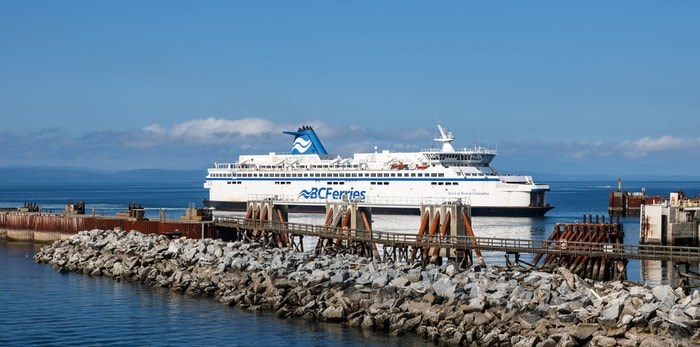VICTORIA — A preliminary decision by the BC Ferries commission would cap annual ferry fare hikes at just over two per cent for five years starting in 2020.
The Office of the BC Ferries Commissioner says in a news release that a maximum yearly fare increase of 2.3 per cent is based on total operating expenses increasing at, or just above, the rate of inflation.
 BC Ferries in Tsawwassen (Volodymyr Kyrylyuk / Shutterstock.com)
BC Ferries in Tsawwassen (Volodymyr Kyrylyuk / Shutterstock.com)
At the same time, Commissioner Sheldon Stoilen expects the trend of increased ferry traffic will level off by next year.
The proposed price cap covers BC Ferries' fifth performance term, which begins April 1, 2020 and ends March 31, 2024.
The commissioner has until September to finalize the decision and public comments are being accepted until the end of June.
BC Ferries was permitted to implement annual fare hikes of up to 1.9 per cent during the last five-year performance term, but Stoilen says average increases were lower than the maximum allowed.
He's pleased the proposed price caps are close to the consumer price index in B.C., but warns holding the line on fare increases could become increasingly difficult.
"The major challenges to operating a world-class system that is affordable to the riding public and taxpayers can be expected to persist and even deepen," Stoilen says in the release.
Fuel costs are the second-highest cost for the service and are estimated at $108.7 million for fiscal 2019 but Stoilen says they have been effectively managed and could decline due to a higher use of liquefied natural gas fuel.
However long-term capital plans will have a moderate impact on the upcoming performance term and "could have a larger impact for following terms," the release says.
Stoilen also points to non-controllable costs in the upcoming performance term such as $19.8 million for the provincial carbon tax, $6.1 million for the new provincial health tax and $19.4 for Canada Pension Plan rates.
He urges BC Ferries to develop a plan for the conversion to all-electric ferries as soon as infrastructure and technology is available.
Other recommendations include possible reductions in the long-term capital plan to ease pressure on future price caps at the publicly owned, independently managed company.
A tracking process and reporting requirement to meet targets for reducing operating, maintenance costs and administration costs should also be developed, Stoilen says.
![]()


